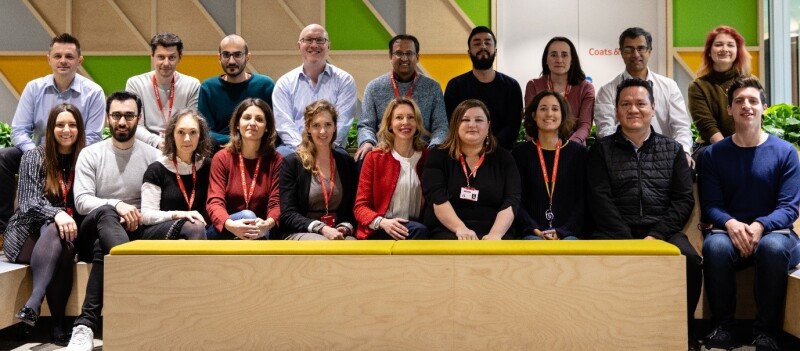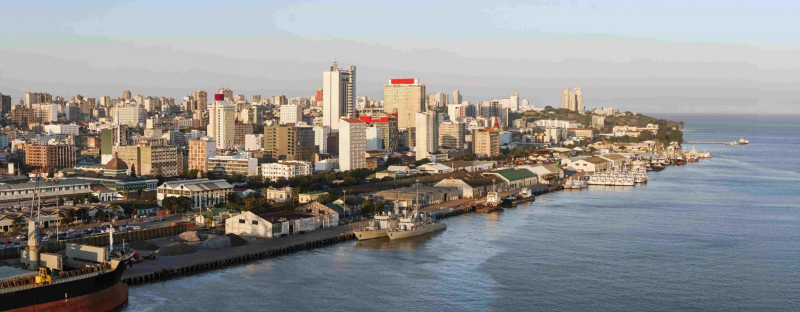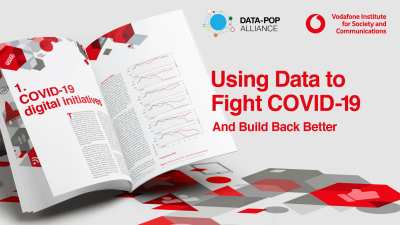A population mapping programme at the University of Southampton supports European governments in understanding how the novel coronavirus might spread. The programme – developed in an association of WorldPop and Vodafone’s Big Data and Artificial Intelligence (AI) team – supports European governments today in understanding how the novel coronavirus might spread. However, this tool has its roots in fighting another deadly disease, malaria, in Mozambique on another continent.
Malaria – one of Mozambique’s biggest killers
Malaria remains one of Mozambique’s biggest killers with 9.3 million cases and an estimated 14,000 deaths in 2018. The impact of malaria is far greater though as it creates poverty, impacting productivity and educational attainment, and also represents a huge burden on the government budget, diverting away scarce resources that could be used elsewhere.
A variety of measures help eliminate malaria, but the movement of people around a country threatens their success. Although malaria is a disease spread by mosquitoes, people who are already infected with the disease can transmit this to mosquitoes as well. So understanding mobility is an important issue in epidemiology.
Long-distance travel can also reintroduce the disease to areas where it was eliminated. This is a particular concern in south-east Africa where, despite efforts to eliminate malaria, the relatively high disease transmission rates in Mozambique threatens low-transmission countries nearby.
When aiming for elimination of any disease, the movement of people and the infections they carry become important in designing strategies. This unique partnership brings together the latest scientific methods with implementation agencies that can translate the findings into action within Mozambique and ensure that data is being used to support evidence-based decision making.
Andrew Tatem, WorldPop’s Director
Data-based mobility estimation
By using anonymised and aggregated data from a mobile network, it is possible to estimate mobility, and see how large groups of people move from one location to the next.
‘One of the important pillars of Mozambique’s strategic plan for malaria is implementing strategies that are appropriate for the epidemiological situation. In this context, understanding the movement of the population and how it relates to the parasite’s movement. This work will contribute clearly to understanding the trends of transmission not only at the regional level between Mozambique, South Africa and Eswatini but also internally within the country. I can see a great opportunity to obtain relevant information that the country requires to understand the malaria transmission in Mozambique and, based on that, to be more strategic with the implementation and thus have a greater impact with our malaria interventions.’
Baltazar Candrinho, National Malaria Control Programme Manager in Mozambique
Vodafone has studied data from more than 80 billion pseudonymised call records, which map the real-time usage of its cell sites across the country, from which can be extrapolated the large-scale flows of people. This data was then combined with malaria incidence maps to detect areas where malaria is likely to be imported into so that interventions and resources can be targeted accordingly.
Initial findings of the malaria research have shown:
- parasite mobility substantially varies month-by-month;
- capturing data at a regional level allows efforts to be more targeted and effective;
- efforts to eliminate malaria in some districts within southern Mozambique could have a lasting effect on reducing cross-border transmission into neighbouring countries; and
- malaria moves more from rural to urban areas than vice-versa.
The next stage of the project will use a year of anonymised call data to explore the effects of seasonality on parasite movement in Mozambique. Other sources such as climate data, travel history surveys and migration data will be used to validate estimates and extend their utility, such as to provide insight into the cross-border movement from Mozambique into Eswatini (Swaziland), South Africa and other neighbouring countries.
Interview with Pedro Rente Lourenço
The Vodafone Group caught up with Pedro Rente Lourenço, who is the lead researcher and data scientist in Vodafone’s Big Data and AI team working on this project, to learn more about big data at Vodafone and the malaria project in Mozambique:

When we talk about Big Data and AI at Vodafone, what is it we are looking at how can it have an impact on services for customers?
Our team have developed complex algorithms that enable us to analyse trends from large scale and pseudonymised data sets generated by our business in order to develop insights that improve the way we support our customers with better products and services.
We try to leverage our data sets for social good and contribute to our purpose as a company. Exemplifying this are our ‘big data for social good’ set of initiatives, and that’s what I’ve been working on.
Where did your interest for working with Big Data start?
Good question! My background is actually in biomedical engineering, and from there it stemmed into neuro-technology and the AI side of things. I started doing AI during my undergraduate degree and then revisited this during my Masters.
I kept this interest, and since then joined Vodafone – a paradise for anyone who wants to work with big amounts of data and AI.
Human movement sustains malaria transmission
Can you tell us how the project with malaria research in Mozambique came about?
This project started as a collaboration with the University of Southampton, and we wanted to see what work could be done where we are present in sub-Saharan Africa with the pseudonymised and then aggregated data that we collect.
There are some great epidemiology experts at the university, with a lot of experience and research on malaria, so we started this collaboration to explore what helpful solutions could be realised from uncovering interesting insights.
Mosquitoes move in a very confined geographical area while people move across the whole country, and so human movement sustains the transmission of malaria, more so than by the movement of mosquitos.
By using mobility datasets, we can have an estimation of mobility, and see how large groups of people move from one location to the next.
Now we are also working with the National Malaria Control Programme in Mozambique, the Bill and Melinda Gates Foundation and the Clinton Health Access Initiative who can provide support in the strategies to help eliminate malaria.
Making a difference
Why did you want to focus on this area, and how can technology really make a positive difference?
It’s interesting for me to look at how you can leverage big data and AI technology to actually make a difference. This technology is something we already have and so we don’t have to create a new infrastructure to collect new data and create new data sources.
I think it’s also the positive impact this area of work can have. Malaria is still one of the biggest killers in the world. The figures are grim, and it is estimated that a child dies every two minutes in the world because of it. In 2017, Africa accounted for about 93% of the worldwide deaths from malaria, so is still very much a big problem there. But the impacts of malaria reach far beyond the deaths as it impacts school attendance, educational performance and work productivity as well as further burdening the health system of one of the poorest countries in the world. Anything we can do to help there has a tremendous impact.
How does this project work towards the UN’s Sustainable Development Goals?
Malaria is a crippling factor in these economies. Goal three is regarding health and wellbeing, so it is clearly working towards that. Indirectly, it is also working towards goal one (no poverty) as malaria causes a large strain to the healthcare system. A quarter of all hospitalisations are due to malaria.
Analyzing and anonymizing large data sets
Have there been any challenges in building this project and technology?
Yes, several. We are talking about very, very large datasets. So obviously it is challenging. The type of analysis we do requires large amounts of computational power, which is not available locally. This means that the team has to anonymise the data locally and then send it to our group servers. Fortunately, our technology enables us to process the large volumes of monthly data.
Are you allowed to use mobile data in this way? How are you ensuring it’s secure and anonymous?
Nothing leaves any market without being pseudonymised (giving data different identifiers, such as alternate names for participants so that researchers can never know or see who’s who).
Even if GDPR and ePrivacy directives do not need to apply in Africa, we ensure the highest privacy standards are always met, and so it becomes impossible to identify individuals.
Any success stories so far?
We gave some initial insight to the Gates Foundation because they helped to build the strategy in eliminating malaria. Proven strategies already exist, such as indoor spraying with insecticide, and giving bed nets for people to sleep at night.
One of the outputs of our work are Malaria Sinks and Malaria Sources. By looking at how people move, and coupling that with the amount of malaria in each area, we can see which regions are exporting malaria, and which regions are importing it.
But the question is: How do you prioritise? Where do you go first, and what are the key areas that you should be focusing on? This is extremely relevant because you want to tackle things at the source – especially in a country so heavily hit with malaria, that has scarce resources. By sharing our data insights, the strategy can focus on the sources of the disease. This means we can take better actions to eliminate malaria.
Cross-sectoral collaboration
How important is it to work with academics and health foundations to make projects like this come to life?
It’s super important. We are not epidemiology experts at Vodafone. We can offer our expertise in terms of data modelling and insights, allowing us to estimate how malaria might move around the country, all whilst preserving privacy and giving completely aggregated and pseudonymised results.
The idea is that by collaborating and getting it done, together, it has real impact.
What are the next steps for this project?
Malaria is complex because it is vector-borne. Vectors are living organisms (parasites, bacteria and viruses) that can transmit diseases to humans, and Vector-borne diseases are human illnesses (such as malaria) caused by the living organisms.
So for example, the population of mosquitos varies seasonally. It depends on temperature, vegetation and rainfall. We want to explore all of the variables and see if we can trace the spread of malaria more effectively if we include these variables in the model.
What does the future of this programme look like? Are there plans to take this to other countries or to use it to track the spread of other diseases?
We could look at malaria beyond Mozambique given the impact of the disease across sub-Saharan Africa.
Application to other diseases is also possible. There’s some work in Ghana through the Vodafone Foundation with Ebola, so this can be done. It can also be used to study cholera and mapping the various levels of vaccination and immunisation.
COVID-19 exit strategies and virus mapping
For a new study on the impact of COVID-19 exit strategies, which is supported by the Vodafone Institute, you cooperate with the University of Southampton. How does the work look like?
For COVID-19, we are sharing the mobility insights along with epidemiological curves we have calculated with the University of Southampton based on our anonymised and aggregated mobility data. This allows us to model different lockdown scenarios.
What did you find out?
We created a set of metrics for “self-isolation” using aggregated and anonymised mobility data. Around the middle of March, and depending on the European country, people started changing their behaviour, by staying at home and moving less during each day. Now, as lockdowns are lifted, this behaviour has changed again.
By monitoring these behavioural changes, we can provide governments with a new way of looking at how effective their containment policies are, and pre-emptively assess the impact that may have on the transmission of COVID-19 – instead of having to wait 14 days to see the effects in the numbers of reported infections. This allows us and other researchers to calculate different lockdown and exit scenarios.
How long did it take to develop such mapping models?
It took around eight weeks. The visualisation tool was the most work dense topic, not only from a technical standpoint. We had many security and privacy requirements – for good reasons! But nevertheless, it’s a testament to my Vodafone colleagues that they developed something like this in such a short period. In the end, this is part of our job, to see how people move across our networks. Therefore, we can provide better networks, better services and find ways out of this crisis. This is a great opportunity to give something back to society and we have embraced it as part of our Purpose: connecting for a better future.
What are the next steps?
We have a big data and AI platform that spans eight European countries and will expand that further. We are working on an updated model that also takes into account the rates of the symptomatic cases and mortality, for example. This will allow us to give even better predictions. It’s an ongoing project, and one I am particularly proud of!



